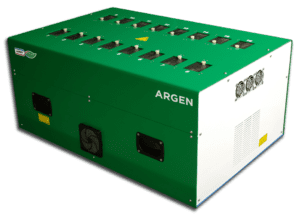
“Based in Rüschlikon (Switzerland), SYSTAG, System Technik AG,is a global company that has been the preferred partner of the chemical and pharmaceutical industry since 1965 thanks to its consistent automation solutions. From development to piloting and process control technology, SYSTAG offers conceptual solutions for process optimization and process safety. SYSTAG provides specialist turnkey solutions for automated laboratory reactors and parallel synthesis workstations, which focus on process optimization from grams to kilograms for the pharmaceutical industry.”
SYSTAG’s engineers were faced with a challenge to optimize one of their flagship products—the FlexyCUBE lab reactor system. The FlexyCUBE is a controlled laboratory reactor that helps process engineers to perform quality risk analysis, parallel process optimisation, and design experiments. The company’s goal was to enhance the device to achieve uniform internal temperature fields.

As a first step, the team wanted to gain insight into the temperature and heat flux distributions in the current reactor assembly. Rather than conduct time-consuming and invasive measurements, they decided to use CAE with SimScale to gather the necessary data. The use of numerical simulations allowed for a cost-effective and efficient way to kick-start the project.
In the last steps, based on the obtained insights, the team went on to modify the identified choke-points to heat flow. They applied CAE simulations to test the optimized construction of the device, without the need to manufacture intermediate design iterations.
The support of SimScale's engineers was crucial to get fast and accurate results as well as overcome any minor obstacles encountered in the process.

Filip Janasz
Research Assistant
The team began by conducting a few experiments with the FlexyCUBE, to gather data and understand the general behavior of the device. Based on the results, they were able to define realistic boundary conditions that were then applied to the heat transfer calculations. Elements of the device were modeled and imported into SimScale where steady-state, thermostructural heat transfer simulations were carried out.

After post-processing the data, the first calculations revealed some non-uniformities in the temperature fields in the reactor vessel. SYSTAG’s team introduced design changes that were further tested with SimScale. Step by step, iteration by iteration, the heat flux and temperature distributions were satisfactorily homogenized.

The overall heat flux variation in the device was reduced by over 60% at measured locations. In total, they ran over 50 simulations on 4 and 16-core machines with an average time of 25 minutes.
SYSTAG’s prototype device had a delivery time of 7 weeks. “Considering we went through 4 virtual prototypes with SimScale, we could say we’ve saved 28 weeks of delivery/manufacturing time for prototypes, plus roughly 10,000 CHF for manufacturing costs,” explains Martin Ritterath, Head of Software, Engineering & Services. The final design went on to be manufactured and tested at SYSTAG, where engineers obtained experimental verification of the heat flux optimization. Virtual prototyping with SimScale saved them a considerable amount of development time and improved the performance of the FlexyCUBE line.

“We saved 28 weeks of delivery/manufacturing time for prototypes, plus roughly 10,000 CHF for manufacturing costs,” explains Martin Ritterath, Head of Software, Engineering & Services.





Sign up for SimScale
and start simulating now